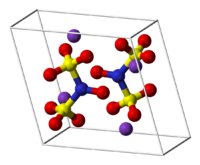Fremy's salt
 |
|
 |
|
| Names | |
|---|---|
|
IUPAC name
Potassium nitrosodisulfonate
|
|
| Identifiers | |
| 14293-70-0 | |
| ECHA InfoCard | 100.034.729 |
| PubChem | 3032624 |
| Properties | |
| K2NO(SO3)2 | |
| Molar mass | 268.33 g/mol (potassium salt) |
| Hazards | |
| Main hazards | Harmful (Xn) |
| R-phrases | R14 R20/21/22 |
| S-phrases | S36 |
|
Except where otherwise noted, data are given for materials in their standard state (at 25 °C [77 °F], 100 kPa).
|
|
| Infobox references | |
Frémy's salt, discovered in 1845 by Edmond Frémy (1814–1894), is a chemical compound and a strong oxidizing agent. The formal name is disodium nitrosodisulfonate or Na2NO(SO3)2, but the expression "Frémy's salt" refers equally well to potassium nitrosodisulfonate, also known as potassium peroxylamine disulfonate. Frémy’s salt (chemical formula: (K4[ON(SO3)2]2) is commonly known as potassium nitrodisulfonate radical dianion (NDS) and potassium peroxylamine disulfonate (K2[NO(SO3)2]). NDS, a product of disassociation of Frémy’s salt, is commonly used to examine the mechanism of oxidation and hydroxylation. Frémy’s salt is a commercially accessible dimer of NDS, it is also a relatively stable source of water-soluble nitroxyl radical that is used as an electronic spin resonance (ESR) standard for g-value determination and radical quantization it is also mainly used in oxidation reactions. Impurities, which may or may not be present in commercial samples, can catalyze the explosive decomposition reaction of this compound in the presence of oxygen.
The nitroso compound is a persistent radical like TEMPO. It is especially useful in oxidations of anilines and phenols to quinones.
Fremy's salt, being a long-lived free radical, is a useful reagent for electron paramagnetic resonance (EPR) work. The molecule gives an intense EPR spectrum dominated by three lines of equal intensity with a spacing of about 13 G (= 1.3 mT). For more details, see Wertz and Bolton (1972).
Fremy’s salt is commonly used in oxidation of aromatic amine and phenol structures. It can also be used as a model for peroxyl radicals in studies that examine the antioxidant mechanism of action in a wide range of natural products. Also are used in the synthesis of metabolites which are found to later bind with DNA. One of its few biological applications involves evaluation of radical scavenging activity and EPR kinetic studies. It is also a useful tool in understanding the reduction mechanism by ascorbic acid (AscH2).
Fremy's salt is commercially available. It can be prepared by the addition of sodium nitrite, sodium bicarbonate, and sulfur dioxide to disodium hydroxylaminedisulfonate and carbon dioxide followed by one-electron oxidation by electrolysis in a basic solution. This reaction must be carried at 5˚C or lower with constant stirring.
...
Wikipedia
